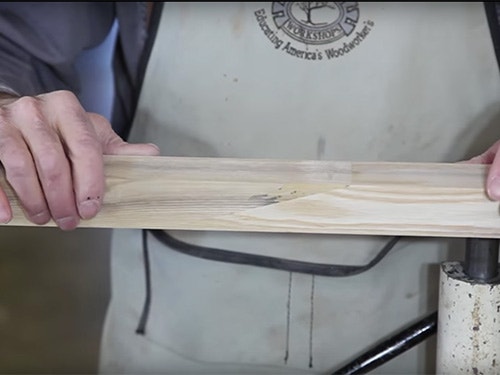Easiest Way to Make a Scarf Joint?
My son and I are building a small sailboat and the plans talk about scarf joints for the battens along the side to which the plywood is attached. What is the easiest way to make them? The material is full 1x2. Thank you for any advice you may have. - Robert Manson
Tim Inman: The scarf joint is just a nice easy way to make short pieces longer, so you don't waste a lot of footage discarding short cutoffs. The scarf joint lets you join the shorter pieces together to make longer ones, using a strong and reliable joint.
There are probably many more elegant ways to make this joint, but here is a "rude and crude" real-world working shop method. First, make a sled jig for your band saw. Then, make the long slanted cuts on the band saw. The nicer the blade, the nicer the cut, but don't go nuts worrying about the "right" blade. Next, make a sled jig for your disc sander. (You do have a disc sander, don't you? If not, a big belt sander would work, too.) Use the sander to clean up the band saw cuts and produce a nice flat surface to glue. Test the angles on your jig and table relative to the disc. This will be very important to get a good fit, and keep a straight line on your battens. This system easily allows longer angles and hence stronger joints than cutting them on a table saw, for example.
It may seem like a crude way to do it, but it works like a charm, and it is easy, fast and repeatable. I would use an epoxy as my adhesive of choice, since you're looking at marine use. Not only is the epoxy adhesive waterproof, it is also a very good gap filler, in the event my clever little jigs leave you with a little less than perfect joint.
A little edge block clamping jig to hold the glue-up while the adhesive is curing would be a nice finish to the batten/scarf jig set. Two scrap boards glued to form a 90 degree corner will make a perfect clamping pad. Wrap the jig or the battens in plastic wrap before you do the clamp-up, though!
Chris Marshall: You also might want to drive a few screws across the scarf joint to reinforce the epoxy bond. It can't hurt to add some mechanical reinforcement, and depending on how you orient the scarf, they wouldn't have to be visible. I'd use good quality, stainless steel screws to avoid any potential corrosion issues down the road...or in this case, river.
Keep the inspiration coming!
Subscribe to our newsletter for more woodworking tips and tricks



